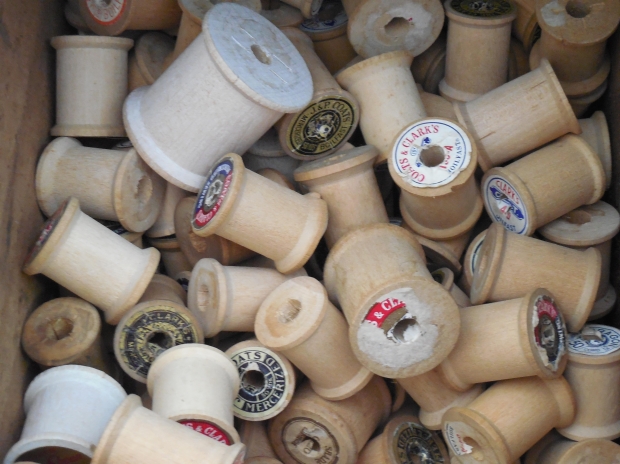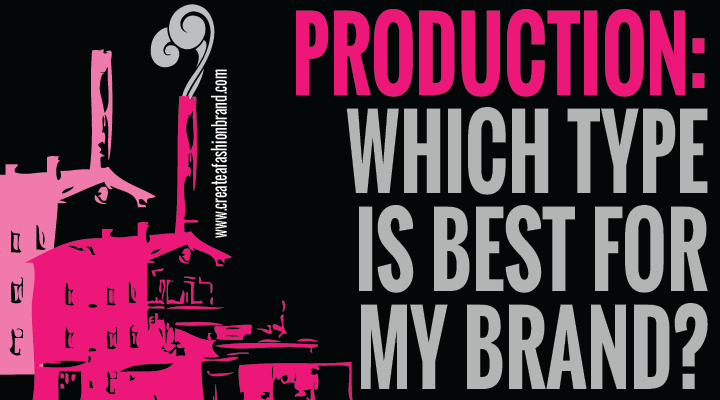So when it comes to getting your products made you have lots of options. Choosing the right one can be a little daunting if you’re not sure which one is right for your brand.
By the end of this post, you’ll have discovered all of the options you have production and know which one is right for your fashion brand.

SO WHAT ARE MY OPTIONS?
So firstly let’s cover exactly what all of the options are from the smallest up to the biggest.
SELF MADE
So the first option you have is to make the products yourself. This one I don’t think needs a lot of explanation except that in terms of cost, you will need to invest in some different machinery to cover the different fabrics you may use and any processes you might want to add like printing or embroidery which can be a little pricey. You can of course get these done separately.
It’s also important to remember that as you’ll be making the products yourself, you’ll have to factor in your time. The products can only be made on a small scale. This can of course increase the value of your products but will also take your time away from other things, so you will have to decide which is more appropriate for your type of product.
DRESSMAKER
A dressmaker option is similar to doing the work yourself, except it’s someone else doing the making for you. Its small scale production so in the same way, the products will never be able to be made on a large scale, however, it’s not your time being taken up which does allow you to do other things.
Since the dressmaker has to invest their time and money in machinery you are quite often paying a premium for their individual service. Additionally, they will usually focus on a limited range of skills so other options like printing and embroidery will have to be done separately.
The last point on this is that depending on where you are in the world, this type of service may or may not be as available to you as you would like or need. For example, in countries like Hong Kong, tailors and dressmakers are very common all over the city, but in the UK, you’d be hard pressed to find one at all. So you may need to check where you could find someone to do the work for you.
SMALL FACTORY
There are many options for small factory units all over the world now. These can vary in size and skill with maybe 10 or less staff.
They will generally have access to most of the industrial machines you will need for your products and have contacts for additional services such as printing and embroidery companies that will also do smaller scale orders.
If you use a small factory, they will be able to produce on mass but at the lower quantity range, so anywhere from 50 to around 200 pieces, although the upper limit will depend on the factory itself. The length of time this will take is obviously quicker than individuals who wouldn’t be able to do such a large order, but won’t be as fast as a large factory. So you will need to factor in extra time for production.
Price is usually cheaper than a dressmaker because you are buying fabric, components and making on a larger scale, however, it’s important to know that the larger the order, the less money each individual product will be.
LARGE FACTORY
A large factory works exactly the same way as a smaller factory, except it’s on a larger scale.
One difference will be price and quantity. The minimum quantity that a large factory will take is around 200 pieces per style upwards into the hundreds of thousands, so that they can maximise the use of the larger machines and additional staff.
Cost per product will go down even further because quantity will go up and your order can be filled very very quickly.
In terms of location, this again may be restricted. To have large scale factories, you need a large volume of land, so you may need to look overseas depending on where you are in the world. The likelihood is that there won’t be one near to where you are located but you do have multiple options across the world.
This may also mean that you will have to ship your products between countries which adds time. Also you will need to understand some laws about customs and importing, as well as filling in paperwork for this to happen legally.
The last difference is that many large factories will be experts in one type of fabric or product, so you may need to find a number of them to cover an entire collection of products. However they do have large admin teams, so additional sourcing can be done by staff for fabrics and additional items such as belts for example at a reduced cost to you also.

THE X FACTOR
So now we know a little bit about the options that are available to you, it’s time to consider which one is best for your fashion brand and why. This of course is a little general and you may need to think about other factors such as cost or the team support that you may or may not have at this point, as well as the availability in your location to these types of manufacturing. Since I don’t know your personal situation, I’m going to concentrate on which is best for the different types of products and market level and you can bear this in mind and tweak as you need to.
HAND MADE
Well this seems fairly obvious. If you are promoting a product as “made by you” then the only option you have is to make it yourself.
However if you want to promote a little more volume and are promoting as “handmade” then there is nothing stopping you from getting a couple of people to help…. Just a thought.
BESPOKE / CUSTOM MADE
Bespoke or custom made brands really have all of the options above apart from the large scale factories. Due to the custom options you want to provide, a small factory will provide a little volume in terms of production whilst retaining that individual feel. If you have the option to have your own team of sewers and pattern cutters, then even better.
However if you are doing a high end product, your clients may in fact expect you to go smaller and have you make it or a dressmaker. This will depend on the type of product and the promises you make your customers of course.
EVERYTHING ELSE….
It might seem strange that I’m lumping everything else together but in fact whether you are doing a high end luxury collection or a mass market value brand, the only decision you really need to make is how much stock do you need and at what quality.
Plenty of luxury brands get their ready to wear garments mass produced in big factories. Some go smaller for the quality or volume and of course couture is done by an in house team of dress makers.
If you are charging a high price, then you have to deliver quality. The higher the price, the more individual attention your customer will demand and the more exclusivity they expect. So the rule is generally this…
The more volume of stock you need, the bigger the production needs to be.
- So 1-20 garments, 1 dressmaker, yourself or a very small team.
- 21-200 items of 1 product, a small factory
- And anything more, a large factory.
In terms of quality, this purely comes down to the factory, dressmaker, tailor or small team you choose and their ability or skill. But again, what customers expect is usually down to price. The higher the price, the more quality you will need to provide.
FINALLY….
So far, in this post we’ve covered the various options that are available in terms of production and what is best for your type of product and fashion brand. Hopefully this will help you to make a decision on what to look for when you need to manufacture your products.
[wc_fa icon=”cogs” margin_left=”” margin_right=””] Action Steps:
Now I want you to take action.
Decide what type of product you want to create in terms of quality and volume.
Look down the options and decide which is best for your fashion brand, the service you offer and the expectations of your customer.
You will now know which one is right for your brand.
P.S
If you want more information on building your fashion brand, then join our weekly Brand Building Email Family by clicking the image below.
PHOTO SOURCE. Morgue File

